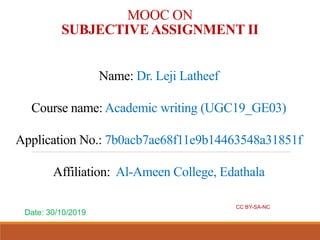Academic writing assignment ii-ppt presentation
- 1. MOOC ON SUBJECTIVE ASSIGNMENT II Name: Dr. Leji Latheef Course name: Academic writing (UGC19_GE03) Application No.: 7b0acb7ae68f11e9b14463548a31851f Affiliation: Al-Ameen College, Edathala CC BY-SA-NC Date: 30/10/2019
- 2. DRUGS ŌĆó The compounds which exert various physiological effects of therapeutic value are known as drugs ŌĆó The treatment of diseases using suitable chemical compounds is known as chemotherapy CC BY-SA-NC
- 3. Antibiotics ’āśMedications used to treat bacterial infections ’āśIdeally, before beginning antibiotic therapy, the suspected areas of infection should be cultured to identify the causative organism and potential antibiotic susceptibilities. CC BY-SA-NC
- 4. TYPES Bactericidal: kill bacteria Bacteriostatic: inhibit growth of susceptible bacteria, rather than killing them immediately; will eventually lead to bacterial death CC BY-SA-NC
- 5. Ideal Qualities ’āśTo kill or inhibit the growth of bacteria ’āśCause no damage to the host ’āśCause no allergic reaction to the host ’āśIt is effective in specific tissues in the body CC BY-SA-NC
- 6. How Antibiotics Work ’āśBlock protein formation ’āśInhibit cell wall formation ’āśInterfere with DNA formation ’āśPrevent folic acid synthesis CC BY-SA-NC
- 7. Ampicillin First introduced in the 1940s Bactericidal: inhibit cell wall synthesis Kill a wide variety of bacteria Also called ŌĆ£beta-lactamsŌĆØ D-alpha amino benzyl pencillin CC BY-SA-NC
- 8. Mode of Action ’ā╝Beta lactum antibiotics (pencillin and ampicillin) act by inhibition of cell wall formation in bacteria ’ā╝Disrupt of peptidoglycan synthesis ’ā╝Inhibiting the action of the enzyme trans peptidase that is necessary for crosslinking of peptidoglycan, which form the skeleton of bacterial cell wall CC BY-SA-NC
- 9. USES Treatment of ’āśUrinary tract infections ’āśBronchitis ’āśInfluenza ’āśTyphoid and paratyphoid fever CC BY-SA-NC
- 10. Chloramphenicol (Chloromycetin) ’āśIt is a broad spectrum of antibiotic ’āśProduced by Streptomyces Venezuelae, an organism first isolated in 1947 from a soil sample collected in Vanezuela CC BY-SA-NC D-(-)-threo-2-dichloroacetamino-1-p-nitrophenyl propane-1,3-diol
- 11. Mode of Action ’āśInhibit microbial protein synthesis ’āśBinds reversibly to the 50S ribosomal subunit of bacteria ’āśInhibit the peptidyl transferase step of protein synthesis ’āśPrevents the formation of peptide bonds CC BY-SA-NC
- 12. Uses Treatment of ŌĆó Typhoid fever ŌĆó Influenza, meningitis ŌĆó Chronic bronchitis ŌĆó Infection of eyes CC BY-SA-NC
- 13. FeedBackonAcademicWriting ’ā╝This Course really worth for me to enriched my knowledge on ’ā╝How to write literature review ’ā╝The importance of cohesion and coherence ’ā╝How to write PhD thesis and research proposal ’ā╝How to avoid plagiarism ’ā╝Awareness on journal matrics and author matrics ’ā╝My sincere thaks to the Academic Writing coordinators for their effors to make this course successful CC BY-SA-NC













